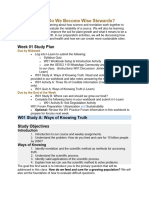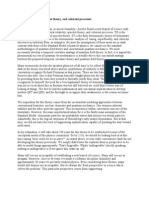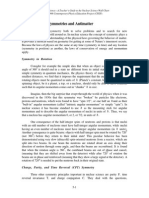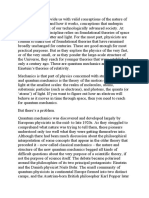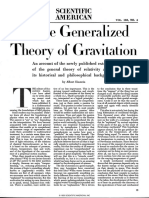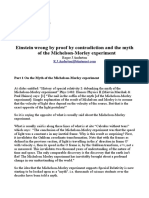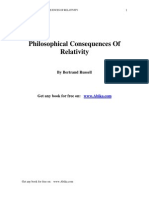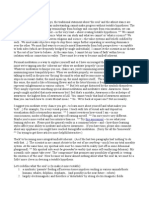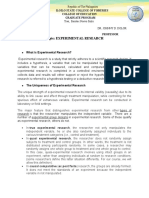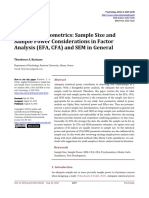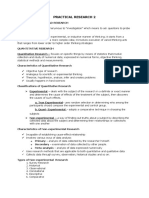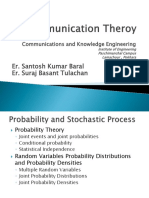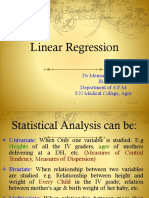A Recap of Motivations
A Recap of Motivations
Uploaded by
sam iam / Salvatore Gerard MichealCopyright:
Available Formats
A Recap of Motivations
A Recap of Motivations
Uploaded by
sam iam / Salvatore Gerard MichealOriginal Title
Copyright
Available Formats
Share this document
Did you find this document useful?
Is this content inappropriate?
Copyright:
Available Formats
A Recap of Motivations
A Recap of Motivations
Uploaded by
sam iam / Salvatore Gerard MichealCopyright:
Available Formats
a recap of motivations For those who missed my several papers citing relevant references, let's recap them so it's
absolutely clear there are solid motivations for 'spacelet theory', an engineering approach toward modeling elementary particles and interactions. 1. Guillaume Adenier disproved Bell's theorem allowing local realistic models to be considered to explain quantum phenomena. 2. GR, a cornerstone of modern physics, asserts spacetime is bent/distorted by gravitating bodies. 3. Bernard Shutz, director of the Astrophysical Relativity Department of the Max Planck Institute, has understood gravitation may be viewed as curved time only. 4. Engineers have always known two facts: a. any media must have elasticity to stretch/deform b. any media must have impedance to impede electromagnetic waves 5. And so, spacetime/time must possess elasticity and impedance. 6. This is no mystery to engineers: they identify 'the impedance of space' as approximately 377 ohms derivable from the 'ideal transmission line' POV. 7. Similarly, 'the elasticity of space' can be calculated and is around 10^22 newtons. 8. But as implied above, the simpler theory (as preferred by Occam) is that these attributes are associated with time alone, leaving space to be Euclidean and flat. 9. It is well known wavelets provide one of the most powerful techniques for analyzing complex data; as i write, wavelets are literally transforming science and engineering. 10. What perhaps is not so well known is that there is an 'uncertainty principle' associated with wavelet theory; this 'wavelet uncertainty principle' bears alarming resemblance to Heisenberg's. 11. We may take this as coincidence with no relevance to quantum physics.. 12. Or we may take this 'coincidence' as a hint about elementary particles.. Some may view this 'chain of logic' above as pure speculation embodying 'fringe' ideas.. But the sequence above may lead to the simplest, deepest, most appropriate and profound view of matter/energy since Einstein's famous equation.. Spacelet, spacetime wavelet, theory may be the 'paradigm shift' required in physics to achieve 'unification' (the quest to unify forces of nature in a coherent and consistent framework). The beauty of this perspective should be immediately obvious: we do it all in 3D+1 dimensions. Another 'bonus' in this framework is that electromagnetism must be mediated by something real, something identifiable, something precisely describable in terms of spacelets: charged antiphotons. The exact properties and shapes must be worked out but preliminary indicators are encouraging. The motivation for proposing something so ludicrous sounding is not simply the need for something real to mediate e-m; we need to consider what may be the core principle in our universe: conservation of curvature. Why do we 'need' this principle? Very simple and practical: we observe spacetime to be flat (or very nearly so) and so any physical processes (such as nuclear fusion or fission) must preserve this 'flatness'. Otherwise, we would observe the curvature of our universe to change over time.. So from observations of curvature alone, we deduce this core principle: curvature conservation. All nuclear reactions (and more) must obey this principle: fusion, fission, pair-production, and perhaps most importantly photon absorption/emission. Every time a photon is created/destroyed/absorbed/emitted, so must an antiphoton. If photons have very slight positive
temporal curvature, then antiphotons must have very slight negative temporal curvature. This is NOT negative energy; it is opposites in temporal curvature. To visualize this, we know time slows down near massive bodies.. We identify this as positive temporal curvature. Near antimatter, time speeds up (NOT reversed time as Dirac proposed) .. So this framework is fully deterministic, local, and REAL. .. The problems with conventional approaches toward quantum mechanics is that they're explicitly UNREAL, non-local, and inherently random. This is essentially why they will never develop an accurate model of gravitation based on virtual exchange; nature don't operate that way. Einstein's dream was to find a coherent and consistent framework (from a realistic POV) to describe quantum phenomena but he was at a disadvantage in his time: wavelet theory had not been developed and physics was pulling away from 'the aether' as a description of space. So anything currently resembling 'the aether' (such as 'the impedance of space') is currently automatically rejected by convention as 'sheer nonsense'. This is an example of the 'politics of science' NOT science. A true scientist considers things objectively, even-handedly, and unbiased-ly. A true scientist does not dismiss based on sounds like the aether to me.. A true scientist will consider viable alternatives. Spacelet theory, admittedly in its infancy, combined with the conservation of curvature principle, may be the simplest most realistic framework possible and we automatically reject it 'cuz it sounds like the aether to me? That don't float in my boat. After 100 years, let's get real physics and fulfill Einstein's dream. .. A presentation scheduled for August 6th will be delivered to the Natural Philosophy Alliance by sam micheal aka sam iam. The website announcing upcoming presentations is here: http://www.worldsci.org/php/index.php?tab0=Events&tab1=Coming Please attend and be a part positive change.
You might also like
- GESCI 110 Week01Document18 pagesGESCI 110 Week01da xzibitNo ratings yet
- David L. Bergman - Unification of PhysicsDocument15 pagesDavid L. Bergman - Unification of PhysicsJuiomSDFNo ratings yet
- Phy-3 Mod1Document28 pagesPhy-3 Mod1Fattah AbuNo ratings yet
- 1924AEinstein ConcerningTheAetherDocument7 pages1924AEinstein ConcerningTheAetherYoshuaRNo ratings yet
- The Fractal UniverseDocument17 pagesThe Fractal UniverseFrancisco MedinaNo ratings yet
- Quantum Physics Interview QuestionDocument3 pagesQuantum Physics Interview QuestionManu Mannu75% (4)
- Quantum Theory Without ObserversDocument21 pagesQuantum Theory Without ObserverscdcrossroaderNo ratings yet
- A Compilation of Documents Relating To Iam SpaceDocument33 pagesA Compilation of Documents Relating To Iam Spacesam iam / Salvatore Gerard MichealNo ratings yet
- Term Paper Electricity and Magnetism PHY102: General Theory of RelativityDocument4 pagesTerm Paper Electricity and Magnetism PHY102: General Theory of RelativityNav89No ratings yet
- Einstein On The Ether 1924 PBDocument5 pagesEinstein On The Ether 1924 PBValter Alnis BezerraNo ratings yet
- Internship Final Report - Applications of Quantum MechanicsDocument11 pagesInternship Final Report - Applications of Quantum MechanicsMuhammad HareesNo ratings yet
- The Hypotheses of Fechner and EinsteinDocument11 pagesThe Hypotheses of Fechner and EinsteinhagamokNo ratings yet
- Phy 101Document33 pagesPhy 101tahasaeed1610100% (1)
- Einstein's GravityDocument28 pagesEinstein's GravityAKARSHNo ratings yet
- Reaction PapersDocument6 pagesReaction PapersGrace SamNo ratings yet
- Ch05 SymmetriesDocument6 pagesCh05 SymmetriesPrichindel MorocanosNo ratings yet
- Calculate But Staty FoolishDocument3 pagesCalculate But Staty FoolishchimkudoNo ratings yet
- What Is MatterDocument7 pagesWhat Is MatterIosif SandoruNo ratings yet
- Moore UnitR Chapters 1 and 2Document42 pagesMoore UnitR Chapters 1 and 2output_running_jumpNo ratings yet
- Manifesto of An Amateur ScientistDocument59 pagesManifesto of An Amateur ScientistJohn WindersNo ratings yet
- Draft: Chris Nunn. New Directions in Consciousness Studies. Routledge. 2016Document6 pagesDraft: Chris Nunn. New Directions in Consciousness Studies. Routledge. 2016Donita SotolomboNo ratings yet
- The Hidden Secrets of General Relativity RevealedDocument8 pagesThe Hidden Secrets of General Relativity RevealedJohn WindersNo ratings yet
- General Problems of Science For PedestrianDocument34 pagesGeneral Problems of Science For PedestrianMia AmaliaNo ratings yet
- We Shall Travel in Space-Time: Memory of Author Critical Studies on Relativity Theory, Space-Time Travels and World Fractal StructureFrom EverandWe Shall Travel in Space-Time: Memory of Author Critical Studies on Relativity Theory, Space-Time Travels and World Fractal StructureNo ratings yet
- 39 Questionable Assumptions in Modern PhysicsDocument10 pages39 Questionable Assumptions in Modern Physics4564016No ratings yet
- Aether, Electromagnetism and Free EnergyDocument16 pagesAether, Electromagnetism and Free Energyxavier102772100% (2)
- 39 Questionable Assumptions v12n3Document16 pages39 Questionable Assumptions v12n3milousNo ratings yet
- The Phi-Wave AetherDocument12 pagesThe Phi-Wave AethervijnanabhairavaNo ratings yet
- Zarah & Pharez: Questions & AnswersDocument15 pagesZarah & Pharez: Questions & AnswersEnrique RamosNo ratings yet
- CosmologyDocument4 pagesCosmologyGulnaz MusinaNo ratings yet
- The Invariance of Spacetime IntervalDocument11 pagesThe Invariance of Spacetime IntervalGeorge Mpantes mathematics teacherNo ratings yet
- Quantum PhysicsDocument3 pagesQuantum PhysicsMilan BasuNo ratings yet
- Einstein 1950 Generalized Theory of Relativity Sci AmDocument5 pagesEinstein 1950 Generalized Theory of Relativity Sci AmbeemitsuNo ratings yet
- R.pearson - Key To Consciousness. Quantum GravitationDocument16 pagesR.pearson - Key To Consciousness. Quantum GravitationJorgee_Porgee_8203No ratings yet
- Nuclear Physics - HandoutsDocument13 pagesNuclear Physics - HandoutsGerry LouNo ratings yet
- Science - Unified Field Theory or Theory of EverythingDocument3 pagesScience - Unified Field Theory or Theory of EverythingKennethOrdoniaNo ratings yet
- Top 10 Useful Theories of Physics To Learn About SettingsDocument5 pagesTop 10 Useful Theories of Physics To Learn About SettingsFinalVideowithSRTNo ratings yet
- Einstein Wrong by Proof by Contradiction and The Myth of The Michelson-Morley ExperimentDocument7 pagesEinstein Wrong by Proof by Contradiction and The Myth of The Michelson-Morley ExperimentConexão Terra PlanaNo ratings yet
- Research Paper On Theory of RelativityDocument9 pagesResearch Paper On Theory of Relativityishita.poonamNo ratings yet
- Quantum Physics For Beginners An Easy and Comprehensive Guide To Learning The Fundamentals of Quantum Physics (Kaufmann, Loew T.) (Z-Library)Document220 pagesQuantum Physics For Beginners An Easy and Comprehensive Guide To Learning The Fundamentals of Quantum Physics (Kaufmann, Loew T.) (Z-Library)KataVuletic100% (2)
- Tombe - Einstein Big MistakeDocument10 pagesTombe - Einstein Big Mistakerr100% (1)
- The Universe On A Tee ShirtDocument26 pagesThe Universe On A Tee ShirtJohn WindersNo ratings yet
- The Electric BridgeDocument12 pagesThe Electric BridgeJayP70100% (1)
- Allen Rothwarf On AetherDocument68 pagesAllen Rothwarf On AetherTinhtet Sein100% (1)
- An Investigation of Negative Gravitational Propulsion.Document33 pagesAn Investigation of Negative Gravitational Propulsion.Armando Milak Pérez100% (1)
- NewScientist - Poster of RealityDocument1 pageNewScientist - Poster of Realityoaky100% (2)
- Concerning The AetherDocument10 pagesConcerning The AetherStephen Shires100% (1)
- Search For Extra Dimension 1Document5 pagesSearch For Extra Dimension 1Parag Mahajani100% (1)
- Albert Einstein - Concerning The AetherDocument6 pagesAlbert Einstein - Concerning The AetherBenjamim GomesNo ratings yet
- Einstein's Special Theory of Relativity and Its Futuristic AspectsDocument2 pagesEinstein's Special Theory of Relativity and Its Futuristic AspectsInternational Journal of Innovative Science and Research TechnologyNo ratings yet
- Bertrand Russell - Philosophical Consequences of RelativityDocument5 pagesBertrand Russell - Philosophical Consequences of RelativitypendleNo ratings yet
- Introduction To Basic Differential CalculusDocument11 pagesIntroduction To Basic Differential CalculusAhmed TahirNo ratings yet
- A New More True Concept and Folmulae of Gravitation Based On The Heat of The Classical Fieldmatter. Newton's Gravitation As A Special Case.Document36 pagesA New More True Concept and Folmulae of Gravitation Based On The Heat of The Classical Fieldmatter. Newton's Gravitation As A Special Case.Constantine KirichesNo ratings yet
- Misner 1969Document6 pagesMisner 1969Anuar Kafuri ZarzosaNo ratings yet
- Physics 12 ISU Special Theory of RelativityDocument9 pagesPhysics 12 ISU Special Theory of RelativityKris NavaratnamNo ratings yet
- What if Einstein Was Wrong?: Asking the Big Questions about PhysicsFrom EverandWhat if Einstein Was Wrong?: Asking the Big Questions about PhysicsNo ratings yet
- Peak Oil, Peak Innovation, and Sustainable NotionsDocument3 pagesPeak Oil, Peak Innovation, and Sustainable Notionssam iam / Salvatore Gerard MichealNo ratings yet
- Nurturing, Managing, and Inspiring SynergyDocument2 pagesNurturing, Managing, and Inspiring Synergysam iam / Salvatore Gerard MichealNo ratings yet
- The Different Faces of SynergyDocument2 pagesThe Different Faces of Synergysam iam / Salvatore Gerard MichealNo ratings yet
- Asimov Vs MichealDocument3 pagesAsimov Vs Michealsam iam / Salvatore Gerard MichealNo ratings yet
- Projects, Goals, and IntentionsDocument1 pageProjects, Goals, and Intentionssam iam / Salvatore Gerard MichealNo ratings yet
- Set TheoryDocument4 pagesSet Theorysam iam / Salvatore Gerard MichealNo ratings yet
- Gamma, The Euler-Mascheroni ConstantDocument1 pageGamma, The Euler-Mascheroni Constantsam iam / Salvatore Gerard MichealNo ratings yet
- Attribute Theory - A PropositionDocument1 pageAttribute Theory - A Propositionsam iam / Salvatore Gerard MichealNo ratings yet
- The Death of Science.Document1 pageThe Death of Science.sam iam / Salvatore Gerard MichealNo ratings yet
- A Proof of God's Existence Based On Information TheoryDocument2 pagesA Proof of God's Existence Based On Information Theorysam iam / Salvatore Gerard MichealNo ratings yet
- More On Mind-Body..Document2 pagesMore On Mind-Body..sam iam / Salvatore Gerard MichealNo ratings yet
- The Unforgivable DeficienciesDocument2 pagesThe Unforgivable DeficienciesPhoenix QuimminerNo ratings yet
- The Soul - A Truly Absurd Concept?Document2 pagesThe Soul - A Truly Absurd Concept?sam iam / Salvatore Gerard MichealNo ratings yet
- About Life..Document2 pagesAbout Life..sam iam / Salvatore Gerard MichealNo ratings yet
- Clean Heart Vs Emotional BaggageDocument2 pagesClean Heart Vs Emotional Baggagesam iam / Salvatore Gerard MichealNo ratings yet
- An Article For Men OnlyDocument3 pagesAn Article For Men Onlysam iam / Salvatore Gerard MichealNo ratings yet
- Quantitative Data Collection TechniqueDocument17 pagesQuantitative Data Collection TechniquemayetteNo ratings yet
- Analisis Pengaruh Kualitas Pelayanan Terhadap Kepuasan Pelanggan Pengguna KartuDocument15 pagesAnalisis Pengaruh Kualitas Pelayanan Terhadap Kepuasan Pelanggan Pengguna KartuHeri Nova ArdiyantoNo ratings yet
- Data Analystics With R Programming - Bhuvaneswari - ContentsDocument6 pagesData Analystics With R Programming - Bhuvaneswari - ContentsSivasankari KNo ratings yet
- The Structure of The Design Process - Roozenburgand Eekels 1995Document46 pagesThe Structure of The Design Process - Roozenburgand Eekels 1995RobNo ratings yet
- Osstmm 3.0 LiteDocument52 pagesOsstmm 3.0 LiteGermán DelgadilloNo ratings yet
- Analytical, Statistical and Managerial Tools For Quality ImprovementDocument15 pagesAnalytical, Statistical and Managerial Tools For Quality ImprovementHemabhushan RaoNo ratings yet
- AAS Determination of Silicon by Flame AASDocument2 pagesAAS Determination of Silicon by Flame AASBayu Adi SamodroNo ratings yet
- PR2 Week 1Document6 pagesPR2 Week 1Argie MabagNo ratings yet
- Chapter 4. Distribution of Sample StatisticsDocument30 pagesChapter 4. Distribution of Sample StatisticsDương Thái ThuậnNo ratings yet
- Sampling and Sampling Methods 2Document80 pagesSampling and Sampling Methods 2Yashpal Singh Bidla50% (4)
- Biostat07 HDocument17 pagesBiostat07 HKanayaNo ratings yet
- Quantitative Research FINALDocument7 pagesQuantitative Research FINALAlfredo ParrenoNo ratings yet
- The Data Science Skills Competency Model: A Blueprint For The Growing Data Scientist ProfessionDocument12 pagesThe Data Science Skills Competency Model: A Blueprint For The Growing Data Scientist Professionthanhloan1902No ratings yet
- Full Paper 137 SEEDS - Testing Team Work Assumptions - Sept17 - v07 E Ayim, J Heathcote & M WilsonDocument11 pagesFull Paper 137 SEEDS - Testing Team Work Assumptions - Sept17 - v07 E Ayim, J Heathcote & M WilsonGhizlane BenNo ratings yet
- Evidence - People Vs CorpuzDocument5 pagesEvidence - People Vs CorpuzAnthony Tamayosa Del AyreNo ratings yet
- M-Iii Unit-2 LNDocument83 pagesM-Iii Unit-2 LN21-390Virkula Manish goud GNITC LEMECHNo ratings yet
- Sample Size and Sample Power Considerations in Factor AnalysisDocument24 pagesSample Size and Sample Power Considerations in Factor AnalysisJay GalangNo ratings yet
- Practice QuestionsDocument2 pagesPractice QuestionsHafsah AnwarNo ratings yet
- Cara Menulis Literature Review Yang BaikDocument6 pagesCara Menulis Literature Review Yang Baikc5qwqy8v100% (1)
- Research Project Plan: Component DescriptionDocument2 pagesResearch Project Plan: Component Descriptionyrah claire labogNo ratings yet
- FRM Quantitative Analysis Test 1 SolutionsDocument4 pagesFRM Quantitative Analysis Test 1 SolutionsConradoCantoIIINo ratings yet
- Descriptive and Predictive Analysis of Euroleague PDFDocument25 pagesDescriptive and Predictive Analysis of Euroleague PDFCoach-NeilKhayechNo ratings yet
- PRACTICAL RESEARCH 2 HandoutsDocument3 pagesPRACTICAL RESEARCH 2 HandoutsSharlyn Balgoa85% (13)
- 307 ImpDocument115 pages307 ImpYash DarajiNo ratings yet
- Er. Santosh Kumar Baral Er. Suraj Basant Tulachan: Communications and Knowledge EngineeringDocument44 pagesEr. Santosh Kumar Baral Er. Suraj Basant Tulachan: Communications and Knowledge EngineeringBiplove PokhrelNo ratings yet
- Consulting Bootcamp - The Book Rev 06Document34 pagesConsulting Bootcamp - The Book Rev 06Will BachmanNo ratings yet
- The Effect of Promotion Cost and Distribution Cost On Company'S Sales of The Fast Moving Consumer Goods IndustriesDocument12 pagesThe Effect of Promotion Cost and Distribution Cost On Company'S Sales of The Fast Moving Consumer Goods IndustriesKarina DewiNo ratings yet
- Levene Test SpreadsheetDocument9 pagesLevene Test Spreadsheetmd_rehan_2No ratings yet
- Bivariate Linear RegressionDocument33 pagesBivariate Linear RegressionHamzahNo ratings yet
